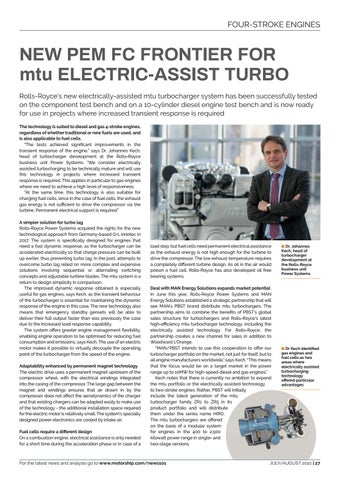FOUR-STROKE ENGINES
NEW PEM FC FRONTIER FOR mtu ELECTRIC-ASSIST TURBO Rolls-Royce's new electrically-assisted mtu turbocharger system has been successfully tested on the component test bench and on a 10-cylinder diesel engine test bench and is now ready for use in projects where increased transient response is required The technology is suited to diesel and gas 4-stroke engines, regardless of whether traditional or new fuels are used, and is also applicable to fuel cells. “The tests achieved significant improvements in the transient response of the engine,” says Dr. Johannes Kech, head of turbocharger development at the Rolls-Royce business unit Power Systems. “We consider electrically assisted turbocharging to be technically mature and will use this technology in projects where increased transient response is required. This applies in particular to gas engines where we need to achieve a high level of responsiveness. “At the same time, this technology is also suitable for charging fuel cells, since in the case of fuel cells, the exhaust gas energy is not sufficient to drive the compressor via the turbine. Permanent electrical support is required.” A simpler solution for turbo lag Rolls-Royce Power Systems acquired the rights for the new technological approach from Germany-based G+L innotec in 2017. The system is specifically designed for engines that need a fast dynamic response, as the turbocharger can be accelerated electrically so that charge pressure can be built up earlier, thus preventing turbo lag. In the past, attempts to overcome turbo lag relied on more complex and expensive solutions involving sequential or alternating switching concepts and adjustable turbine blades. The mtu system is a return to design simplicity in comparison. The improved dynamic response obtained is especially useful for gas engines, says Kech, as the transient behaviour of the turbocharger is essential for maintaining the dynamic response of the engine in this case. The new technology also means that emergency standby gensets will be able to deliver their full output faster than was previously the case due to the increased load response capability. The system offers greater engine management flexibility, enabling engine operation to be optimised for reducing fuel consumption and emissions, says Kech. The use of an electric motor makes it possible to virtually decouple the operating point of the turbocharger from the speed of the engine. Adaptability enhanced by permanent magnet technology The electric drive uses a permanent magnet upstream of the compressor wheel, with the electrical windings integrated into the casing of the compressor. The large gap between the magnet and windings ensures that air drawn in by the compressor does not affect the aerodynamics of the charger and that existing chargers can be adapted easily to make use of the technology - the additional installation space required for the electric motor is relatively small. The system's specially designed power electronics are cooled by intake air. Fuel cells require a different design On a combustion engine, electrical assistance is only needed for a short time during the acceleration phase or in case of a
load step, but fuel cells need permanent electrical assistance as the exhaust energy is not high enough for the turbine to drive the compressor. The low exhaust temperature requires a completely different turbine design. As oil in the air would poison a fuel cell, Rolls-Royce has also developed oil free bearing systems.
8 Dr. Johannes Kech, head of turbocharger development at the Rolls-Royce business unit Power Systems
Deal with MAN Energy Solutions expands market potential In June this year, Rolls-Royce Power Systems and MAN Energy Solutions established a strategic partnership that will see MAN's PBST brand distribute mtu turbochargers. The partnership aims to combine the benefits of PBST's global sales structure for turbochargers and Rolls-Royce's latest high-efficiency mtu turbocharger technology, including the electrically assisted technology. For Rolls-Royce, the partnership creates a new channel for sales in addition to Woodward L'Orange. “MAN/PBST intends to use this cooperation to offer our turbocharger portfolio on the market, not just for itself, but to all engine manufacturers worldwide,” says Kech. “This means that the focus would be on a target market in the power range up to 10MW for high-speed diesel and gas engines.” Kech notes that there is currently no ambition to expand the mtu portfolio or the electrically assisted technology to two-stroke engines. Rather, PBST will initially include the latest generation of the mtu turbocharger family ZR1 to ZR5 in its product portfolio and will distribute them under the series name HIRO. The mtu turbochargers are offered on the basis of a modular system for engines in the 400 to 2,500 kilowatt power range in single- and two-stage versions.
8 Dr Kech identified gas engines and fuel cells as two areas where electrically assisted turbocharging technology offered particular advantages
For the latest news and analysis go to www.motorship.com/news101
JULY/AUGUST 2021 | 27







